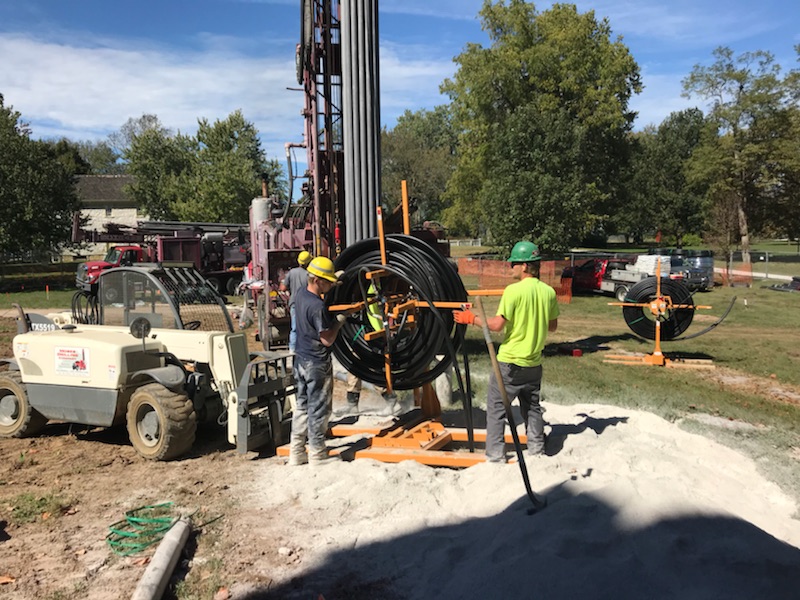NOTICE: PRESERVATION@WORK Geothermal drilling will commence no earlier than 8:30 a.m. and will cease no later than 6 p.m. each day Oct. 2-6. Noise and vibration are to be expected.

Work on the Centre Family Dwelling and Meeting House has begun! And with that comes chainlink fences, construction equipment and loud noises. Sounds lovely, right? Actually, it really is! It’s the sound of preservation@work—work that will extend the lives of these two buildings, work that will prepare them for new interpretive experiences, work that would make the Shakers proud. So, while your Shaker Village experience will be different for the next year, we ask that you embrace this project and use it as a learning opportunity. During the next 12 months, our daily adventures schedule will feature special tours and activities highlighting the work being done on both buildings. We want you to be a part of this village@work project. Come see what’s happening! Ask questions, take a tour or read more here.
First up on the to-do list is drilling wells for the geothermal heating and cooling system.
Q: What are geothermal wells?
A: Geothermal wells are wells that tap into the natural energy found beneath the Earth. These wells will be attached to water source heat pumps inside the buildings, which maintain stable indoor temperatures.
Q: How does a geothermal system work?
A: The surface of the Earth can get quite cold or hot at times. The area beneath the Earth’s crust has a relatively stable temperature and geothermal energy utilizes this heat to provide heating or cooling for structures.
Q: How many wells are we drilling?
A: 36 total—24 for the Centre Family Dwelling and 12 for the Meeting House.

Q: How deep are the wells?
A: 380-400 feet!
Q: How are the wells connected to the building?
A: Each well has “unicoil” of pipe inside the well, a “supply” and “return in the shape of a U.” Each well is inter-connected into a pipe system, known as the “loop.” The main supply and return pipes are connected to pumps inside the building. This is known as a “closed loop” system. The system is sealed so no fluid is exchanged with the environment.
Q: What’s in the pipes?
A: The pipes are filled with glycol, a fluid similar to antifreeze in your car. The fluid doesn’t freeze and can transfer heat better than ordinary water.
Q: So how does it all work?
A: In winter, the system collects the Earth’s natural heat through the loop. The fluid circulates through the loop and carries the heat to the building. There, an electrically-driven compressor and a heat exchanger concentrate the heat and release it inside the building at a higher temperature. Ductwork distributes the heat to different rooms. In summer, the process is reversed. The loop draws excess heat from the building and allows it to be absorbed by the Earth.
Q: Isn’t it expensive?
A: The short answer is yes. Creating the infrastructure of wells and piping is a cost we have chosen to incur. We also have to create duct work and piping on the building interiors to distribute the heat or air conditioning. Our design team worked tirelessly to do this in ways that are sympathetic to the buildings so the systems are mostly hidden. When we are finished, you will have to look really hard to see where we added them.
Q: Why did Shaker Village choose geothermal?
A: Part of Shaker Village’s mission is to be good stewards of our resources. Geothermal helps us do this in two ways. First, geothermal heat pump systems are more than three times as efficient as the most economical furnace. Instead of burning a combustible fuel to create heat, a ground-source system uses the earth’s energy as heat. Geothermal systems provide three to four units of energy for every one unit used to power the system’s compressor, fan and water pump. The U.S. Department of Energy and the Environmental Protection Agency identify geothermal as having the lowest environmental impact of all heating systems. Secondly, geothermal systems are able to reach very high efficiencies. For example, geothermal heat pump can be up to 600 percent efficient on the coldest days of the year—a normal air source heat pump will only be 175-200 percent efficient on cool days—meaning the geothermal system is using far less electricity than a comparable heat pump, furnace or air conditioner. Thus, this installation will help us save financial resources in the long run on our purchase of electricity.
This project has been in the works for decades. The systems installed during the 1960s in the Centre Family Dwelling and Meeting House should’ve lasted 25-30 years, but we extended the life of those systems 50 years. Now, it’s time to dedicate the time and resources necessary to prolong the lives of these buildings for the next generation. When we are finished, guests will have a better experience inside the buildings during hot or cold days—regulating the temperature and humidity inside the building help us preserve the buildings and allow us to display furniture and textiles that are too fragile for non-climate controlled spaces. Some big long-term wins for a few weeks of noise and dust.
Preservation work is never completed—ongoing repair, maintenance and upkeep is critical for the sustainability of this site. Thanks to your donations and site revenue, projects like this are possible.
William Updike is the vice president for natural and cultural resource management…